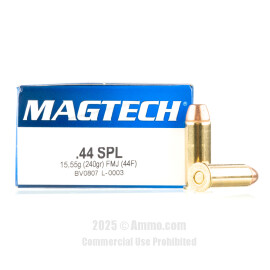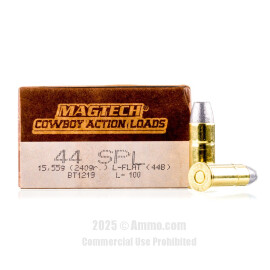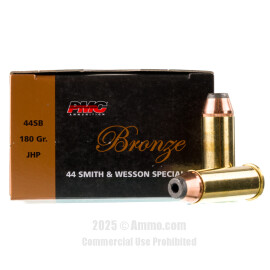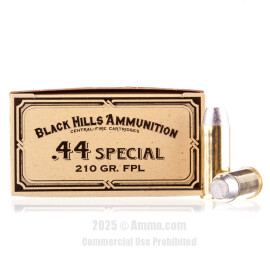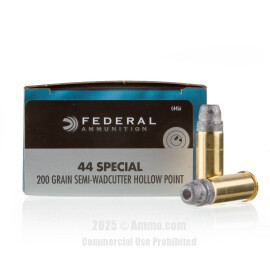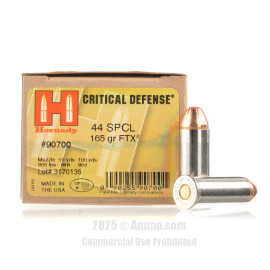
44 S&W Special Ammo For Sale
Overview of 44 S&W Special Ammo
At the turn of the 20th century, Smith & Wesson wanted to release a new revolver and decided to create a new caliber for the 1908 “triple lock” .44 Hand Ejector, also known as the 1st Model New Century Revolver. S&W started with the .44 S&W Russian, an ammunition created in 1870 as a military revolver for the Imperial Russian Army, and set out to improve on its features.
S&W wisely opted for smokeless powder, the newest ammunition innovation of the time, instead of the traditional black powder used in the .44 Russian. Yet the quantity of smokeless powder far exceeded the black powder used in the older cartridge, so S&W lengthened the ammo’s casing by .19 inch to make room for six more grain (gr) of powder. This change created slightly more power with the same size bullet, but otherwise, the round mimicked the .44 Russian’s accuracy and performance ballistics.
44 Special is a rimmed, centerfire cartridge featuring a .429-inch diameter bullet sitting in a case that’s .457 inches wide and 1.16 inches long. The full length is 1.615 inches, and it uses a large pistol primer. According to the Sporting Arms and Ammunition Manufacturers’ Institute (SAAMI), the organization that sets the standard for modern ammunition, the .44 Special’s maximum load is 15,500 pounds per square inch (psi), although many handloaders would disagree with this standard.
How Does The 44 S&W Special Compare To Other Calibers?
| Caliber | Recoil | Pros | Cons |
|---|---|---|---|
| 44 Magnum | 44 S&W has higher | 44 S&W has higher and more powerful, better terminal ballistics, and more shooting applications like hunting | 44 S&W has drastically higher recoil and is more expensive to shoot |
.44 S&W Special Ballistics: Chart of Average .44 S&W Special Ballistics
The .44 Special really is a special cartridge. It’s extremely accurate. It’s reliable. And it comes with a versatility not seen in many ammunitions. And when it comes down to ballistics, most factory loads show impressive performance.
Note: This information comes from the manufacturer and is for informational purposes only. The actual ballistics obtained with your firearm can vary considerably from the advertised ballistics. Also, ballistics can vary from lot to lot with the same brand and type load.
| 44 S&W Special Bullet WEIGHT | Muzzle VELOCITY (fps) | Muzzle ENERGY (ft. lbs.) | Mid-Range TRAJECTORY (in.) | Barrel Length (in.) | |||||
|---|---|---|---|---|---|---|---|---|---|
| Muzzle | 50 yds. | 100 yds. | Muzzle | 50 yds. | 100 yds. | 50 yds. | 100 yds. | ||
| 165 Grain FTX | 900 | 848 | 802 | 297 | 263 | 235 | n/a | n/a | 2.5" |
| 180 Grain | 980 | n/a | n/a | 383 | n/a | n/a | n/a | n/a | 6.5" |
| 180 Grain | 1000 | 935 | 882 | 400 | 350 | 311 | n/a | n/a | 7.5-V |
| 200 Grain | 875 | 825 | 780 | 340 | 302 | 270 | 1.2 | 6 | 6" |
| 200 Grain | 1035 | 940 | 865 | 475 | 390 | 335 | 1.1 | 4.9 | 6.5" |
| 210 Grain | 900 | 861 | 825 | 360 | 329 | 302 | 5.57 | n/a | 6" |
| 240 Grain | 755 | 725 | 695 | 310 | 285 | 265 | 2 | 8.3 | 6.5" |
| 246 Grain | 755 | 725 | 695 | 310 | 285 | 265 | 2 | 8.3 | 6.5" |
Customer Reviews
-
Rdb said:
Very good performance and value
-
Larry S. said:
This was a great price and the ammo is great quality, no issues
-
ccw4ohio said:
For reliability I'd rate it 3 out of 5. Several rounds had to be smacked 2-3 times before they ignited. I think PMC is still using those hard primers that made me steer away from the Starfire line. Accuracy was 5 out of five. Affordability was 3 out of five. Yes, you guys delivered just like you said, but the shipping cost was much more than I expected. I might have to run a few more boxes through for another reliability test. The load was totally controllable out of a S&W Model 29 "Dirty Harry" signature .44 Magnum, 6.5 in bbl., target was set at 21-25 ft.
-
dave said:
nice one
